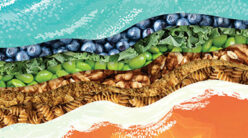Vibrant Life: Give us an idea of the scope of the diabetes problem.
Dr. Barnard: It is reaching epidemic levels. There are 200 million people or more who have it. Year by year it gets more common. The Centers for Disease Control and Prevention in Atlanta estimates that children born since the year 2000 have a one in three risk of developing diabetes at some point in their lives. Most of them will not develop it as children but as adults, but one in three is an astronomical figure we’ve never had before.
Vibrant Life: Why is diabetes becoming more common?
Dr. Barnard: The cause really is the Western diet. To give it to you in a nutshell, type 1 is less common and used to be called childhood-onset diabetes. The cells of the pancreas that make insulin have been killed off. There is evidence that cow’s milk exposure may be the cause of that because proteins in cow’s milk trigger the production of antibodies that can destroy the insulin- producing cells. That is a theory, but it happens to be a leading theory for Type 1 diabetes.
Type 2 diabetes is much more common and used to be called adult-onset diabetes. In this condition, the cells of the body are resistant to insulin. The way to think of it is that insulin acts like a key that opens the cell membranes to allow glucose (blood sugar, that is) to let it inside the cell so that sugar can act to power the cell. And in Type 2 diabetes, the cells are formed a little bit different. It turns out that if you look inside the cells, you discover that they’re filled with fat. Fat from chicken, fat from beef, fat from cheese, different fats from fryer grease. Because the amount of these products has increased dramatically, diabetes is becoming more common as well.
The average American consumes about 50 pounds more meat now than they did in the 1960s. Every year your average American now consumes about 32 pounds of cheese a year. That’s about 15 pounds more than in 1960s.
Vibrant Life: Are dairy products, or animal byproducts, just as unhealthy as meat?
Dr. Barnard: Yes. They’re just as unhealthy, if not more so. If you take a slice of cheese, it’s about 70 percent fat. Most of that fat is saturated fat: that’s bad fat. It’s the kind that raises the cholesterol levels. So it is as bad or worse than meat itself.
Vibrant Life: Many people who have been diagnosed with diabetes feel discouraged, fearing diabetes is a condition that will unavoidably worsen. What is your message to them?
Dr. Barnard: We have some rather important news. We need this news, because diabetes does get worse. For most people it leads to terrible complications. About 75 percent of people with diabetes have a heart attack and die of it. It’s the leading cause of blindness, the leading cause of amputation, the leading cause of kidney failure. But the good news is that starting in 2003, the National Institutes of Health funded my research team to test a very different diet for diabetes. We took out all the animal products, we kept the vegetable oil very low, and we kept sugar low. But people could eat unlimited amounts of vegetables and fruits, whole grains, and beans. So if they got out of bed in the morning and they wanted to have oatmeal, nobody told them how big of a bowl to have: they could have all they wanted. And as long as their food skipped the animal products and kept the oils and sugars low, they could eat unlimited quantities. And what we found was that the improvement in blood sugar was about three times better with this diet than with the conventional diabetes diet.
Vibrant Life: So you’ve seen your patients get dramatically better?
Dr. Barnard: Everyone has a different result. What we saw is that their condition gets dramatically better. People lose weight, sometimes remarkable amounts of weight. Their blood sugar falls. Their need for medication drops, and their long-term complications are going to be much less common.
Let me give you an example. There was a man in our study named Vance. Vance had been a Washington DC policeman for about 12 years. His father was dead by age 30. Vance was 31 when he was diagnosed with diabetes. In our study, he was in very poor control of his diabetes. He was quite overweight. He went on a vegan diet, and he loved it. We didn’t make him count carbohydrates grams or any of that stuff. He lost about 60 pounds over the course of the first year. His doctor stopped all of his diabetes medicine, and if you checked his blood sugar, you never would have known he had diabetes.
Vibrant Life: Do you find people are surprised when you say you can eat all you want, that you don’t have to count calories or measure portions?
Dr. Barnard: You don’t have to measure your portions. You don’t have to measure your calories or your carbohydrates grams. Because everything you’re eating is healthy for you.
Vibrant Life: You have structured your recommendations around what you call the new four food groups. Tell us about that.
Dr. Barnard: Some of us grew up with the old four food groups: meat, dairy products, grains, and fruits and vegetables. Vegetables and fruits had to share a group. But the new four food groups are vegetables, fruits, whole grains, and legumes. Legumes is just a fancy name for beans, peas, and lentils-things that come in a pod.
So for breakfast that might be a bowl of oatmeal. For lunch it might be beans and rice or vegetarian chili or something like that. For dinner, maybe it’s spaghetti with a marinara sauce.
Vibrant Life: I’m sure you hear questions about how to get calcium and protein on the diet you’re recommending.
Dr. Barnard: Well there’s plenty of protein in beans, vegetables, and whole grains. And, by the way, you don’t have to specially combine these things. A lot of people imagine that, “Well, I betcha there’s protein in there. Don’t you have to combine beans with greens to a certain ratio?” And the answer is no. You don’t do anything. You just eat the foods you like [from the new four food groups], and you’ll get the protein you need.
Calcium is in the greens and beans, so green leafy vegetables like broccoli or kale or collard greens-you name it-have calcium. Also the bean group-beans and peas-also have a lot of calcium in them, so you’ll get the calcium you need. These same foods, the greens and the beans, are good sources of the iron mineral. So they have not just calcium, but iron also, for example.
Vibrant Life: This is a drastic idea for many people. What advice do you have for those considering this change?
Dr. Barnard: Well it sounds harder than it is and we have a way of introducing it to people that works 100 percent of the time. Basically there are two steps.
Step 1: Just go shopping. In other words, let’s say you pick up some groceries and you find some recipes you like. Go buy the food and see how you like it. If you’ve never made a vegetable curry before, go to the store and try it out. If you don’t like to cook and you eat convenience food like frozen pizza, well, based on that, try a vegan pizza. Try it out. Or if you eat hot dogs, go get veggie hot dogs. So, in other words, step one is not to follow a vegan diet. Step one is to try out the foods and see how they are. Try it for a week or so.
Step 2: Take a three-week period and test-drive it for a time. You already know which foods you like. For every breakfast, lunch, and dinner, you happen to be vegan, with low fat and low sugar. At the end of that time, two things will have happened: the first is you’ll feel better. Your blood sugar is down, your cholesterol is starting to fall, you’ve lost weight, you’re feeling better, your energy is better, and your digestive problems are probably gone in the first 48 hours.
The second thing is your taste will change. Where this is really familiar with people is when you switch from whole milk to skim milk. A lot of times people don’t like skim milk at first. It’s watery, weird looking. But then after about two or three weeks, they totally adapt to it, and when they try to go back to whole milk again, it tastes thick and creamy and they don’t like it. Well, if you lighten your entire diet, the first week it doesn’t seem quite right. The second week you’ll get adapted to it. The third week, go back and have a double bacon cheeseburger, and it’s just sickening and greasy. So your taste really does change. I’m not suggesting skim milk as health food. I’m just using this as an example of when people use a diet change. Take soy milk or rice milk, or something like that. There’s a different taste too, but after a couple of weeks you’re thinking, “Nobody would ever drink cow’s milk, would they?”
Vibrant Life: What about foods such as refined sugars. Some people say, “I’ve got to have my chocolate or a soda.” Do you find after that three-week period, even the craving for those foods has diminished?
Dr. Barnard: Yes, I think they do. If a person has a little chocolate once a month or a soda once a month, if it’s not really affecting them, I don’t really care. But for the most part, people don’t eat like that. They get into a rut. They have a soda every single day. Or they have chocolate every single night, and they end up paying a price for that. So, in that case, I think it’s good to just set it aside. Not forever: you don’t consciously do it forever. But set it aside for three weeks. At the end of that time you’ll find that it just doesn’t call to you so much. We crave today what we had yesterday.
Vibrant Life: Besides dietary changes, what other lifestyle choices help prevent, control, or reverse diabetes?
Dr. Barnard: Exercise is very helpful. Exercising muscle tone tends to pull sugar out of the blood even without insulin. It also helps people to lose weight. And it makes people feel better, so they’re less likely to turn to snacking. But having said that, there are some people who cannot exercise. Their heart is weak, their joints are bad, or they’re so massively overweight that meaningful exercise is sort of out of the question. So I want to reassure those people that the benefits that I described-in our research study-those benefits were achieved without exercise because we wanted to isolate the effect of diet alone. So exercise is good but it’s not absolutely essential if you’re unable to do it.
The other thing, let me just make a pitch for rest. Once your clock hits 10:00 p.m., turn out your lights and go to sleep. There are an awful lot of people who tend to stay up, and a couple of things happen. The first is they eat. They’re snacking. And one of the nice things about being unconscious and sleeping is that you cannot make your way to the refrigerator! The other thing is when you are resting, your body repairs and resets and gets ready for the next day. What I mean is, a person who does not sleep has poorer pain control, poorer mood control, and has poorer appetite control. Look at an accountant on April 13 and 14. They’re not sleeping; they’re eating junk food. They are never going to quit smoking on that day. Everything kind of goes to pot. On the other hand, if you went to sleep and you feel well, the next day you’re less likely to fall prey to food cravings.
One last thing is that we should think about our relationships a little bit. For some families, everybody wants to make a diet change but they’re not quite in sync. So one person may have a pretty serious weight problem, but the rest of the family is thinking, “Well I’m not quite sure, do I want to do the vegan thing?” I think it’s good for the whole family to make a change together. And the way to do it is that the most motivated one, the person who is really pushing for it, suggest to everybody that they do a three-week test as a group project. So the family may not want to change forever, but they’ll say, “All right, we’ll try it.” And then during that time, everything that’s on the fridge, everything on the shelf happens to be vegan and everybody kind of gets used to it. And it becomes very, very easy. It’s hard if your family is teasing you and tempting you, and that kind of thing.
Vibrant Life: Now if there is someone who wants to do this, is it important that they talk to their doctor? Is this something they need to be working out with their medical professional?
Dr. Barnard: I think there are two things should be discussed with a doctor: one is medication, and the other is exercise. If you’re on diabetes medication, the medication might be too strong for you. If a person is on insulin, for example, the insulin is pushing your blood sugar down, but sometimes your diet brings the blood sugar down on its own. So insulin combined with a good diet can actually make your blood sugar go too low. That doesn’t mean there’s anything wrong with the diet; it means that the medicine is something you don’t entirely need anymore. But don’t throw it away just on your own. What you should do is talk with your doctor, your doctor will say, “Fine, check your blood sugar on your own at home. Call me if it gets too low, and we’ll back you off your dose.” And that’s perfect.
Vibrant Life: They should ask their doctor about exercise as well?
Dr. Barnard: Some people claim their hearts may be weak, their joints may be bad, and those people need to be cautious about exercise. The doctor can advise them about that too. So I encourage people, before you make a diet change, let your healthcare provider know what you’re doing, get the green light about exercise, and once you’ve got it, jump in!
Vibrant Life: Personally what led you to choose a vegan diet?
Dr. Barnard: I’ve been tinkering with my own diet for a very long time. The year before I went to medical school, I had a job helping out at autopsies in Minneapolis Hospital. There was a man who had died in the hospital of a massive heart attack, and we had to examine his heart. And so the way you examine the heart of a dead body is you take a clipper, and you cut through the ribs on the left side and the right side, and then you remove the section of ribs. You take out the chest and set it on the table, and that exposes the heart. The heart was filled with athrosclorotic plaque, which comes from the cholesterol fat that people eat. At the end of the exam, we took the ribs and put them back in the chest. I sewed up the skin, and cleaned up, and then I went up to the cafeteria-where I discovered they were serving ribs for lunch. Somehow between the smell and the look of it, I was unable to eat it. As time went on I started learning more and more about what is a healthy diet and what is an unhealthy diet, and decided I wanted to stop eating meat. Later I decided to stop eating dairy products. And later on I decided I wanted to make sure that my foods were relatively unprocessed. More vegetables. More fruits. And then I just kept working on it ever since then.
Vibrant Life: Do you find resistance to these ideas?
Dr. Barnard: Well, yes, but I welcome resistance. Resistance doesn’t mean no. For example, if you say to a patient, “We’ve done research showing that your diabetes will get a lot better if you follow a vegan diet, setting aside meats, keeping oil and sugar intake really low,” the patient will be resistant. That’s natural. They’ll say, “Well, I wouldn’t know what to eat. I travel a lot and my family will try to divorce me.” Many doctors would interpret that as refusal. That’s not refusal. That’s just resistance. And what resistance is, it’s laying out the challenges that need to be overcome in order to be able to accept the recommendation. Now the person says, “I travel a lot.” Okay, fair enough. Well if you’re at Taco Bell, because you’re in your car between sales calls, don’t get the meat taco, get the bean burrito and hold the cheese. Or if you’re at a hotel eating Italian, skip the meat sauce and have the tomato sauce. But you’re working through it. “My family will be all upset,” they might say. You know, maybe they would have some questions. Well the next appointment, bring them in, and let’s talk together. In the meanwhile, bring my book home and maybe you can share it around a little bit. Or try an informative DVD. Why don’t you put it in the TV, and let’s talk about it? You may find that your family members would like to lose a few pounds. And maybe we could make this a family project. So, yes, people are resistant. I respect it and I welcome it, because once they express their resistance, what they’re really expressing is the questions to which they need answers.
Vibrant Life: So your response to resistance is education?
Dr. Barnard: Education and encouragement. And the thing I don’t say is, “Well, do the best you can.” I really try to push people to do it all the way, rather than give people passive permission to goof it up.
Vibrant Life: What if they did it in part? Do you still see improvements if they give up some meat or dairy?
Dr. Barnard: Every vegan meal they have is a step in the right direction. And a person who is not ready to commit to it, having more of these meals is a good idea. Having said that, at some point, I think that everybody ought to do it all the way, at least for that three-week period. And if they stick with it, they’re going to do a lot better than if they do it only part way.
Vibrant Life: What is the one thing you want people to know about diabetes?
Dr. Barnard: This disease can be reversed. When I say reversed, what I mean is if you’re having higher and higher blood sugar, those blood sugars can start to fall. If you’ve had higher and higher medication doses, those doses can start to fall. If you’ve had more complications, those complications can diminish and in some cases be prevented. I don’t mean to say that everybody who has diabetes will have a cure, but I do mean to say that people can improve, and in some cases improve dramatically.






